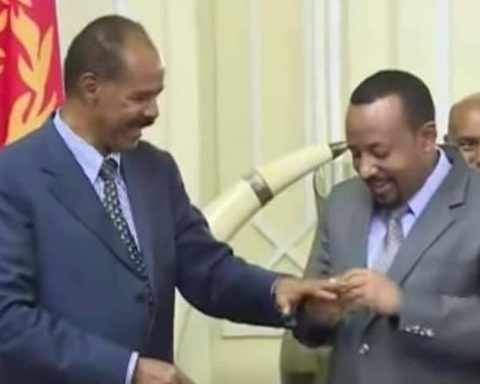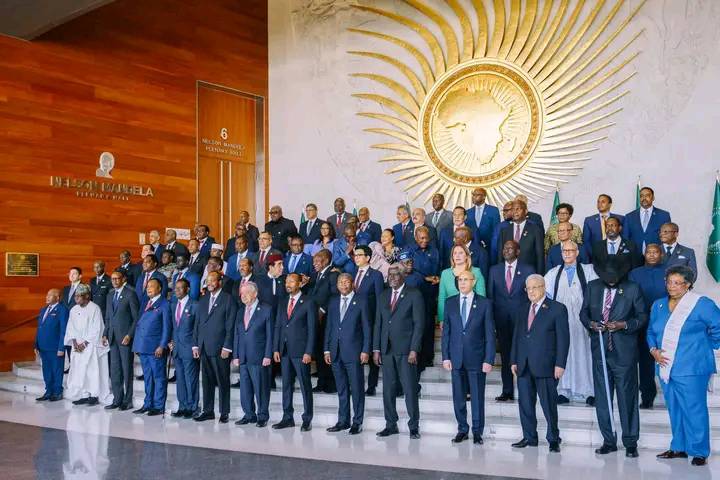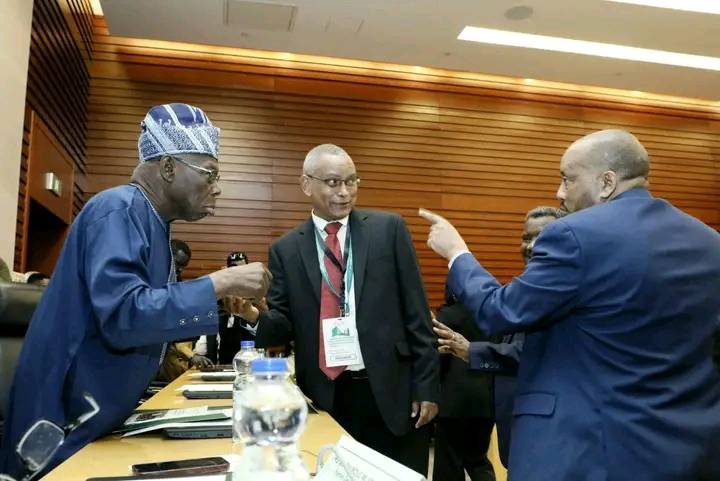 Aklog Birara, PhD
Aklog Birara, PhD
“We must avoid the pitfalls of tribalism. If we are divided among ourselves on tribal lines, we open our doors to foreign intervention and its potentially harmful consequences.
Until the philosophy which holds one race superior and another inferior is finally and permanently discredited and abandoned, that until there are no longer first-class and second-class citizens of any nation; that until the color of a man’s skin is of no more significance than the color of his eyes; that until the basic human rights are equally guaranteed to all without regard to race; that until that day, the dream of lasting peace and world citizenship and the rule of international morality will remain but a fleeting illusion.“
Emperor Haile Selassie I
I once again listened to a powerful and most inspirational keynote speech by Her Excellency Mia Amor Mottley of Barbados. I was not at all surprised by the heads of state and government assembled in Addis Ababa who applauded her; and hopefully, inspired by her presentation.
She framed the policy issues facing Ethiopia and the rest of Africa in a manner that suits the current situation, with the Prime Minister of Ethiopia listening. It is hard for any rational person, especially Abiy Ahmed Ali to argue and dismiss her quote of Emperor Haile Selassie “There can no longer be first-class and second-class” citizens if Ethiopia and the rest of Africa wish to enjoy peace and stability.
The Barbadian Prime Minister presented the “Adwa spirit” in a manner that strengthens Ethiopia’s huge contributions to national liberation across the entire Africa, the Caribbean, and the rest, to the ongoing and unfinished doctrine of Pan-Africanism and to the formation of the Africa Union.
African liberation is an unfinished business so long as foreign powers force Africans to serve as pawns of foreign powers and interests. Ethiopia is at the heart of this tragic situation. The regime has succeeded in polarizing Ethiopia as never before in its history.
Ethiopia, the sponsor of the African union and a country that fought for freedom and independence against colonial and imperial powers throughout its history cannot afford this harmful division along tribal lines. Nor can it afford to serve as a pawn for any foreign power or interest. Free people cannot be pawns.
The fact today is this. Ethiopia that hosts the African union suffers from this tragedy of ethnic divide and conquer. It is against itself. It is against itself because it is war torn and conflict ridden. It is operating against the “Adwa spirit” of unity with diversity the Barbadian Prime Minister presented with aplomb.
I remind the reader Ethiopia has never enjoyed peace and stability for half a century. I also remind the reader that eighty-six percent of Ethiopians are multidimensionally poor.
What does this mean?
This means they suffer from hunger, malnutrition of millions of children, inadequate health services and shelters, lack of modern sanitation, lack of access to electricity, lack of job opportunities and more.
Just look at the following chart and think repeatedly?
There is no doubt in my mind Amhara faces an existential threat. It must defend itself. This painful reality Amhara faces is further aggravated by a bleak socioeconomic, financial, and budgetary situation that affects most Ethiopians, especially war-torn regions like Tigray, Amhara, and Oromia. The severity of the problem differs from region to region, from one ethnic group to another. Think of most Ethiopians as human beings and as citizens. Think of skyrocketing prices and impact on most Ethiopians.
Even if you ignore economic and social collapse in the Amhara and Tigray regions due to conflict and war, you cannot ignore the level of deprivation most Ethiopians face today.
Ethiopia is among the least developed countries in the world. It continues to suffer from a low level of human development. The government of Ethiopia refuses to acknowledge the depth and breadth of multidimensional poverty in the country.
If we take the UN sanctioned Sustainable Development Goal I that aims “to end poverty in all its forms everywhere,” Ethiopia’s status is dismal. In 2024, the UN Human Development Index (HDI) of 112 developing countries shows severe deprivation (multidimensionally poor/MPI) for most Ethiopians.
Because Ethiopia is a conflict-ridden country, the latest Human Development Report survey data that were publicly available for Ethiopia’s MPI estimation refer to 2019, one year after Prime Minister Abiy Ahmed took power. “Based on these estimates, 68.7 percent of the population in Ethiopia (eighty-six million (86,185,000 people in 2022) is multidimensionally poor while an additional 18.4 percent (twenty-three million people in 2022) is classified as vulnerable to multidimensional poverty.
The intensity of deprivations in Ethiopia, which is the average deprivation score among people living in multidimensional poverty, is 53.3 percent. “
I acknowledge the fact that Ethiopia has achieved significant transformation in social and economic infrastructure like roads, rails, colleges, and universities.
In 2023, the World Bank, the largest multilateral donor to Ethiopia reported that “approximately sixty million Ethiopians still lack access to safe drinking water, contributing to 7 percent of the global water crisis, and over 112 million are without basic sanitation facilities, with twenty-two million continuing open defecation. Water contamination remains a critical challenge, exacerbated by insufficient sanitation infrastructure, leading to the spread of diseases such as cholera and diarrhea. In 2017, water-related diseases were a leading cause of death, second only to undernutrition. The ongoing conflict also aggravates water scarcity by uprooting communities and destroying water systems.”
Regardless of how you look at it, most Ethiopians suffer from multidimensional poverty. This includes low annual income, poor health services, lack of access to sanitation, safe drinking water, adequate shelter, education, dearth of employment opportunities for the country’s youth etc.
The value and purchasing power of the Ethiopian Birr has declined dramatically over the past year. Even those with higher income levels like medical doctors, and teachers earning more than the minimum UN poverty rate of $2.15 per day are no longer able to meet basic needs.
The government’s financial and monetary policy of structural adjustment to please multilateral lending institutions like the IMF and the World Bank has harmed Ethiopian society and is thus a failure.
In 2024, Ethiopia’s GDP declined by 60 percent due to war and conflict in the country, particularly the war in Tigray, followed by another war in the Amhara region which disrupted economic activity, hampered mobility and investment, and strained public finances. This is further compounded by issues like a weak foreign reserve position, high debt levels, and an overvalued currency, leading to limited access to external financing and hindering economic growth.
Ethiopia failed to learn from the disastrous effects of structural adjustment programs in the rest of Africa.
Macrotrends informs us Ethiopia’s defense spending increased to $1.03 billion at the end of 2022, whopping 11.4 percent from the previous year. Ethiopia is not at war with a foreign power. It is at war with itself. This business model does not make sense.
In 2024, internationally confirmed 15.8 million and an estimated twenty million Ethiopians estimated by reliable sources required emergency food aid; of the total 5.4 of 6 million citizens in Tigray alone need food aid.
More than 5,500 schools, 4,178 of them in the Amhara region have been closed due to Abiy’s war against Amhara and similar conflicts in other parts of Ethiopia. Millions of children are out of school. This affects the future generation.
In 2020-2022, Ethiopia was home to 5,1 million internally displaced persons (IDPs), one of the largest in the world. Displacement is caused by war in the north and drought in the South and South-West, famine in Wollo and internal displacements.
Recent reports indicate that the Abiy Ahmed regime has diverted humanitarian World Food Program aid to fund military operations, including the purchase of drones used against Amhara civilians. This blatant misuse of international relief efforts not only exacerbates the suffering of millions but also constitutes a grave violation of human rights.
In 2023, USAID employees discovered that donated food was being diverted across Ethiopia in a “systematic” way and on an “industrial level,” according to a presentation by the agency’s preliminary investigation. The Ethiopian military was regularly redirecting donor-funded wheat to private mills to be turned into flour for its soldiers, the presentation said. And “predatory racketeers” were manipulating the hungry into selling them their rations.
In 2024, Global Hunger ranked Ethiopia 102nd out of 127 countries where hunger is a serious development policy problem for the society.
Ethiopia continues to be an aid dependent country since 1952. In 2024, foreign aid contributed 28 percent of the total federal budget. Yet, the structure of the economy remains the same.
One year ago, Prime Minister Abiy Ahmed declared that Ethiopia will no longer seek food aid in a year or so. Taye Atsekeselassie, President, declared in February this year that Ethiopia’s wheat production and self-sufficiency demonstrates development success under the Abiy regime.
At the end of 2022, the United Nations ranked Ethiopia 176th out of 193 counties in terms of its human development index (HDI), among the lowest in Africa.
The 2024 Fragile States Index identifies Ethiopia 11th out of 179 countries surveyed.
Ethiopia’s economy is mismanaged.
and is in Free Fall:
The current government of Ethiopia is in total denial of the depth and breadth of Ethiopia’s troubles. It offers glitz like streetlights, palaces, and resorts as a symbol of progress.
Yet, Ethiopia’s farmers still use Biblical farming tools to feed themselves and the country’s bulging population.
There is no contest that most Ethiopians face a bleak and an uncertain future. This conclusion requires a change in thinking in our thinking.
What do I recommend?
First, Ethiopians must acknowledge the intractable, systemic and governance hurdles their country, and its 130 million people are facing. If we do not agree on the core problem, there is no way we can solve the problem.
Second, Ethiopians who believe in the country and its diverse population must coalesce together and stop the carnage now.
Third, those fighting for Amhara survival must set aside their differences and agree on a unity of purpose, forge an Amhara wide institution, structure, and leadership. An appropriate road map must guide the effort.
Fourth, Ethiopians must begin to think and operate beyond ethnic affiliation and identity. They must decide to face the notion that the ethnic federal system has failed. Ethiopians together have the lead responsibility to replace ethnic federalism by a citizenship-based model and by an empowering federal administrative system like best practices across the globe.
Fifth, the root cause of multidimensional poverty is Ethiopia’s elite-capture development model. We must produce a better alternative development model that stimulates growth, productivity, employment, and residency. The Adwa spirit teaches us that we can do this if we change our paradigm of thinking.





